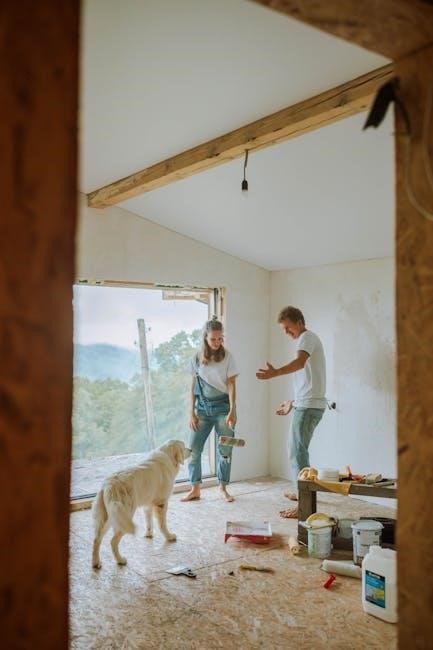House building plans are detailed blueprints guiding home construction, offering layouts, technical specifications, and design elements. They ensure organization, compliance, and cost-efficiency, making them essential for any project. Available in PDF format, these plans provide a clear roadmap for builders and homeowners, ensuring successful execution from start to finish.
1.1 What Are House Building Plans?
House building plans are detailed architectural blueprints that outline the structural and aesthetic elements of a home. These plans, often available in PDF format, provide a visual representation of the floor layout, elevations, sections, and other technical specifications. They serve as a roadmap for contractors, ensuring that the construction process adheres to the designer’s vision. House plans typically include measurements, materials, and construction methods, making them essential for obtaining permits and complying with local building codes. They also allow homeowners to visualize their space and make informed decisions about customization. Whether modern or traditional, these plans are adaptable and can be tailored to suit various lifestyles and budgets.
1.2 Importance of House Building Plans
House building plans are crucial for ensuring a smooth and successful construction process. They provide a clear blueprint for contractors, helping to avoid costly errors and delays. By outlining precise measurements, materials, and layouts, these plans ensure compliance with local building codes and zoning regulations; They also serve as a visual guide for homeowners to understand the final structure. Having a well-detailed plan fosters better communication between architects, builders, and clients, reducing misunderstandings. Additionally, house plans help in estimating costs accurately and making informed decisions about design modifications. Overall, they are indispensable for achieving a safe, functional, and aesthetically pleasing home that meets the owner’s needs and regulatory standards.
Benefits of Using House Building Plans
House building plans streamline construction, reduce errors, and save time. They provide clear blueprints, ensuring projects stay on budget and meet regulatory standards, while offering design flexibility.
2.1 Cost Efficiency
House building plans significantly enhance cost efficiency by providing detailed blueprints that minimize construction waste and optimize resource allocation. Free PDF plans, such as those offered by Truoba, allow homeowners to visualize and budget accurately without additional design costs. These plans often include budgeting tools and cost estimation guides, ensuring projects stay financially manageable. By utilizing pre-designed layouts, individuals can avoid costly modifications and ensure materials are used efficiently. Additionally, downloadable PDFs eliminate the need for expensive professional consultations, making it easier to stick to a budget. This approach not only saves money but also ensures that the final product aligns with the allocated resources, reducing financial risks and ensuring a successful build.
2.2 Time-Saving
House building plans in PDF format offer significant time-saving benefits by providing pre-designed layouts and detailed blueprints. These plans streamline the design and approval process, eliminating the need for lengthy consultations with architects. Free and paid PDF plans are readily available for download, allowing homeowners to quickly access and review multiple designs. Many plans include floor plans, elevations, and sections in easy-to-print formats, ensuring rapid decision-making. Additionally, tools like CAD software and online design platforms further accelerate the process by enabling quick modifications. With these resources, users can focus on construction rather than spending time on design from scratch, making the entire project more efficient and timely.

Types of House Building Plans
House building plans vary, including one-story, two-story, modern, and traditional designs, catering to diverse preferences and lifestyles. These plans offer flexibility and customization options.
3.1 One-Story vs. Two-Story Plans
When exploring house building plans, one-story and two-story designs are popular choices. One-story plans offer simplicity and convenience, ideal for open layouts and aging-in-place scenarios. They are often preferred for smaller lots and ease of accessibility. In contrast, two-story plans maximize space on larger plots, providing privacy and separation between living and sleeping areas. Both options are available in PDF formats, allowing easy customization and visualization. Homeowners should consider lifestyle, budget, and land size when choosing between these layouts, ensuring the selected plan aligns with their needs and preferences for functionality and aesthetics.
3.2 Modern vs. Traditional Designs
Modern and traditional house designs cater to different aesthetic preferences. Modern plans emphasize minimalism, open spaces, and contemporary materials like glass and steel, often featuring sleek lines and innovative layouts. Traditional designs, however, focus on classic elements, such as symmetry, ornate details, and timeless charm. Both styles are widely available in PDF formats, allowing homeowners to explore and customize layouts to suit their tastes. Modern designs often incorporate energy-efficient features, while traditional plans may offer a sense of nostalgia and permanence. Choosing between these styles depends on personal preferences, lifestyle, and the desired atmosphere of the home. Each option provides unique benefits, ensuring a tailored living space.
How to Choose the Right House Building Plan
Selecting the ideal house plan involves assessing your lifestyle, budget, and location. Consider space needs, daily routines, and future requirements. Evaluate design preferences, ensuring compliance with local codes. Prioritize cost efficiency and sustainability, and use design tools for visualization. Ensure the plan aligns with long-term goals and is customizable to meet your needs effectively.
4.1 Assessing Lifestyle Needs
Assessing lifestyle needs is crucial for selecting the right house plan. Begin by evaluating your daily routines and preferences. Consider the number of bedrooms and bathrooms required, ensuring they align with household size. Think about open floor plans for socializing or private spaces for tranquility. Storage needs, such as closets or garages, should also be evaluated. Additionally, consider features like home offices, outdoor living areas, or entertainment spaces based on your hobbies and work style. Prioritizing these aspects helps in narrowing down designs that best suit your family’s lifestyle and preferences, ensuring a functional and enjoyable living environment.
4.2 Considering Budget Constraints
Considering budget constraints is essential when selecting house building plans. Evaluate total costs, including materials, labor, and permits, to ensure affordability. Compare free and paid plans, noting that paid options often offer more customization. Free plans may save money upfront but could require additional investments for modifications. Assess whether the design aligns with your financial capacity, balancing needs and wants. Prioritize essential features to stay within budget while achieving your vision for a functional and comfortable home. This careful financial planning ensures your project remains feasible and stress-free.

Customization Options
House building plans offer customization, allowing modifications to existing designs or creating entirely new layouts. This ensures homes suit specific needs, budgets, and aesthetic preferences effectively.
5.1 Modifying Existing Plans
Modifying existing house building plans allows homeowners to tailor designs to their preferences without starting from scratch. This approach saves time and reduces costs. Changes can include adjusting room layouts, adding windows, or altering exterior finishes. Many PDF plans are editable, enabling users to make revisions using design software. Websites like Truoba and Renovation Headquarters offer customizable templates, ensuring modifications align with local building codes. Professional services are recommended to ensure compliance and structural integrity. This flexibility makes existing plans a practical choice for those seeking personalized homes without the expense of custom designs.
5.2 Creating a Custom Design
Creating a custom house design offers a tailored solution to meet specific needs and preferences. This approach involves collaboration with architects or designers to craft a unique blueprint. Advanced software like CAD and online tools enable precise customization, from floor layouts to exterior aesthetics. Custom designs ensure functionality, personal style, and energy efficiency. They also allow for sustainable features and future adaptability. While more time-consuming than using templates, custom designs provide a home perfectly suited to lifestyle and budget, making the investment worthwhile for those seeking a personalized living space.

Legal and Regulatory Requirements
Understanding legal and regulatory requirements is crucial for constructing a home. Zoning laws and building codes ensure safety and compliance, necessitating professional oversight to avoid violations and delays.
6.1 Zoning Laws
Zoning laws regulate land use, dictating where and how homes can be built. These laws vary by location, governing lot size, setbacks, height restrictions, and allowable uses. Compliance is essential to avoid legal issues, as violations can halt construction or lead to fines. Homeowners must research local zoning ordinances before finalizing house plans, ensuring their design aligns with all regulations. Zoning laws also impact aspects like parking, landscaping, and outdoor structures, making them a critical consideration in the planning process. Consulting with local authorities or a legal expert can help navigate these requirements effectively, ensuring a smooth construction experience.
6.2 Building Codes
Building codes are essential regulations ensuring structures are safe, durable, and meet minimum standards. They govern aspects like fire safety, electrical systems, and insulation, varying by location and climate. Compliance with these codes is mandatory, and failure can result in fines or construction halts. House plans must incorporate local building codes, addressing elements such as materials, structural integrity, and energy efficiency. Regular inspections ensure adherence, making codes a critical component of the construction process. Homeowners and builders must stay informed about updates to these regulations to avoid legal or safety issues. Adhering to building codes ensures a safe and structurally sound home, protecting both occupants and investments.

Sustainable and Energy-Efficient Design
Sustainable house plans emphasize eco-friendly materials and energy-saving features, reducing environmental impact. Designs incorporate green technologies, optimizing natural light and insulation for long-term efficiency and lower utility costs.
7.1 Green Building Materials
Green building materials are essential for sustainable house plans, offering eco-friendly alternatives to traditional resources. These materials, such as reclaimed wood, bamboo, and low-VOC paints, reduce environmental impact while maintaining durability and aesthetics. Energy-efficient designs often incorporate recycled metals, like aluminum and steel, which can be repurposed and reused, minimizing waste. Additionally, materials like insulated concrete forms and straw bales provide superior insulation, reducing energy consumption. Sustainable materials not only support environmental conservation but also promote healthier indoor air quality, making them a cornerstone of modern, eco-conscious home construction.
- Reclaimed wood reduces deforestation and landfill waste.
- Bamboo is a highly renewable resource with a fast growth rate.
- Low-VOC paints improve indoor air quality.
- Recycled metals offer durability and sustainability.
- Insulated concrete forms enhance energy efficiency.
By integrating these materials, house plans can achieve both environmental and economic benefits, ensuring a greener future for homeowners.
7.2 Energy Efficiency Features
Energy efficiency features are crucial for reducing energy consumption and lowering utility costs in modern homes. These include solar panels, high-efficiency HVAC systems, and insulation materials like spray foam or fiberglass. Double- or triple-pane windows minimize heat loss, while energy-efficient appliances and LED lighting further reduce energy use; Smart home technology, such as thermostats and lighting controls, optimizes energy consumption. These features not only cut costs but also align with sustainable living goals. By integrating these elements into house plans, homeowners can create eco-friendly, cost-effective living spaces that support long-term energy savings and environmental conservation.
- Solar panels for renewable energy generation.
- High-efficiency HVAC systems for optimal heating and cooling.
- Advanced insulation materials to reduce heat loss.
- Energy-efficient appliances and LED lighting.
- Smart home technology for energy management.
These features ensure homes are both eco-friendly and economically viable.

Budgeting and Costing
Budgeting and costing involve estimating expenses, allocating resources, and adhering to financial constraints. Effective planning ensures affordability, utilizing cost-saving strategies and tools for precise budget management.
8.1 Estimating Costs
Estimating costs is a critical step in house building, requiring a detailed breakdown of materials, labor, and permits. Using free house plans in PDF format can help identify expenses early, ensuring budget adherence. Tools like Excel sheets for construction costing provide structure, while online resources offer pre-calculated estimates. Factors such as location, design complexity, and local regulations significantly impact costs. Accurate estimation avoids overspending and ensures smooth project execution from planning to completion.
8.2 Cost-Saving Strategies
Implementing cost-saving strategies is essential for managing house building expenses. Utilizing free house plans in PDF format can reduce design costs significantly. Opting for simple, functional designs minimizes material waste and labor fees. Energy-efficient features, such as solar panels or insulation, lower long-term utility bills. Using locally sourced, sustainable materials often reduces expenses while supporting eco-friendly practices. Additionally, pre-fabricated components and DIY approaches for non-critical tasks can cut costs without compromising quality. Regularly reviewing and adjusting budgets ensures alignment with financial goals. By combining these strategies, homeowners can achieve significant savings while constructing their dream homes effectively.

Tools and Software for Design
Essential tools include CAD software for precise blueprints and online design tools for customization. These resources help create and modify house plans efficiently, ensuring accuracy and creativity in the design process.
9.1 CAD Software
CAD (Computer-Aided Design) software is a powerful tool for creating detailed house building plans. It allows architects and designers to draft precise 2D and 3D models, ensuring accuracy in measurements and layout. Popular CAD programs include AutoCAD and SketchUp, which are widely used in the construction industry. These tools enable users to visualize the project, make adjustments, and generate professional blueprints. CAD software supports PDF exports, making it easy to share plans with contractors and clients. Additionally, CAD files can be integrated with other software for cost estimation and project management, streamlining the entire building process.
9.2 Online Design Tools
Online design tools provide an accessible and user-friendly way to create and customize house building plans. Platforms like RoomSketcher and Floorplanner allow users to design floor plans and visualize spaces in 2D and 3D. These tools often feature drag-and-drop interfaces, making it easy for both professionals and homeowners to experiment with layouts. Many online tools offer libraries of furniture, fixtures, and materials to enhance designs. They also support collaboration, enabling multiple users to work on a project simultaneously. Additionally, these platforms frequently include features for generating PDF exports, ensuring that plans are ready for sharing or submission. Online design tools are ideal for those seeking flexibility and convenience in the planning process.
Downloading Free House Plans
Free house plans in PDF format are widely available online, offering customizable designs for various styles and budgets. Websites like Truoba and Renovation Headquarters provide easy downloads for modern, traditional, and tiny homes, enabling homeowners to explore and modify plans according to their needs.
10.1 Where to Find Free Plans
Free house plans in PDF format can be found on various websites specializing in architectural designs. Platforms like Truoba, Renovation Headquarters, and House Plan Files offer a wide range of downloadable plans. These sites cater to different styles, from modern minimalist homes to traditional family designs. Additionally, websites like Nethouseplans and Indianplans provide region-specific and Vaastu-compliant plans. Many of these resources allow users to filter plans by bedrooms, square footage, and design preferences. Before downloading, it’s essential to review the terms of use and ensure the plans align with local building codes and regulations. Always verify the credibility of the source to ensure the plans are reliable and suitable for your construction needs.
10.2 Evaluating Free vs. Paid Plans
When choosing between free and paid house plans in PDF, consider factors like customization and detail. Free plans are ideal for those with limited budgets or needing inspiration, offering basic designs that can be modified. However, they often lack comprehensive details like electrical layouts or structural specifications. Paid plans provide fully detailed blueprints, including floor plans, elevations, and sections, ensuring compliance with local building codes. Paid options also offer customization services, tailored to specific needs. For small or simple projects, free plans suffice, but for complex builds, investing in paid plans is advisable to avoid costly modifications later. Evaluate your project scope and requirements to decide which option best fits your needs. Always check reviews and credibility of sources for both free and paid plans to ensure quality and reliability. This careful evaluation ensures your project starts on a solid foundation, whether you choose free or paid house building plans. Proper planning prevents future issues and guarantees a successful construction process.
Case Studies and Examples
Explore real-world examples of successful house builds using PDF plans, showcasing modern minimalist homes and traditional family designs. These case studies highlight effective design, functionality, and practical execution.
11.1 Example 1: Modern Minimalist Home
This modern minimalist home features clean lines, open spaces, and eco-friendly materials. The PDF plan includes a one-story layout with three bedrooms, two bathrooms, and a minimalist kitchen. Designed for simplicity and functionality, the house incorporates large windows for natural light and energy-efficient features. The floor plan emphasizes flow and versatility, perfect for small families or couples. Available for free download, this plan offers a cost-effective solution for those seeking a sleek, contemporary home. Builders can easily customize the design to suit their needs while maintaining the minimalist aesthetic. This example showcases how modern design can blend seamlessly with practical living;
11.2 Example 2: Traditional Family Home
This traditional family home features a classic two-story design with a symmetrical facade, a welcoming porch, and a cozy interior layout. The PDF plan includes a spacious living room, dining area, and kitchen on the first floor, with four bedrooms and two bathrooms upstairs; Designed for families, the home emphasizes comfort and practicality, blending timeless aesthetics with modern functionality. The plan is available in both PDF and AutoCAD formats, making it easy to customize. With a focus on traditional materials like brick and wood, this design aligns with local building codes while offering a charming, family-friendly atmosphere. The backyard space is ideal for outdoor activities, creating a perfect balance between indoor and outdoor living.
Avoiding Common Mistakes
Avoiding mistakes in house building requires careful planning and adherence to local codes. Common errors include poor layout design, inadequate material estimation, and ignoring zoning laws, which can lead to costly delays and legal issues. Always consult professionals to ensure compliance and accuracy in your house plans. Proper preparation and attention to detail are key to a successful project.
12.1 Inadequate Planning
Inadequate planning is a common mistake that can lead to significant issues during house construction. Without a detailed house building plan, projects often face delays, budget overruns, and design flaws. Proper planning involves assessing lifestyle needs, budget constraints, and local regulations. Many homeowners overlook the importance of consulting professionals, such as architects and engineers, which can result in non-compliance with building codes. Additionally, failing to consider future needs, like family expansion or accessibility, can render the house unsuitable in the long run. A well-structured plan ensures that all aspects are addressed, minimizing the risk of costly revisions and ensuring the home meets its intended purpose effectively.
12.2 Ignoring Local Building Codes
Ignoring local building codes is a critical mistake that can lead to severe consequences, including legal penalties, safety hazards, and costly rework. Building codes ensure that structures are safe, durable, and environmentally compliant. Homeowners who overlook these regulations risk facing fines, project halts, or even demolition orders. Additionally, non-compliance can result in insurance issues and liability problems. Proper house building plans must adhere to local codes, including zoning laws and structural requirements. Professional oversight is essential to navigate these regulations effectively. Neglecting this step can turn a dream project into a financial and legal nightmare, emphasizing the importance of thorough planning and compliance from the outset.
House building plans are essential for successful construction. They ensure compliance, efficiency, and safety. Choose your plan wisely and consult professionals to bring your vision to life today.
13.1 Final Thoughts
House building plans are a cornerstone of successful construction, offering clarity, efficiency, and compliance. With numerous free PDF plans available, homeowners can explore diverse designs, from modern to traditional, ensuring their vision aligns with lifestyle and budget. Customization options allow for personalization, while tools like CAD software and online platforms simplify the design process. Legal requirements and sustainability should never be overlooked. By leveraging these resources and considering professional guidance, individuals can turn their dream home into a reality. Stay informed, plan meticulously, and embrace the journey to creating a space that reflects your unique needs and aspirations.
13.2 Next Steps
Once you’ve explored house building plans and selected a design, the next steps involve preparing for construction. Start by researching local zoning laws and building codes to ensure compliance. Create a detailed budget, including materials and labor costs, and explore cost-saving strategies. Download free PDF plans or purchase customizable designs that match your needs. Consider consulting architects or contractors for professional advice and modifications. Finally, gather necessary permits and begin the construction process with confidence. Remember to prioritize sustainability and energy efficiency to create a home that meets both your current and future needs while minimizing environmental impact.